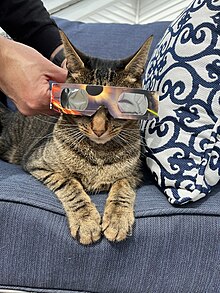


Solar viewers (also known as solar viewing glasses or solar eclipse glasses) are special eyewear designed for direct viewing of the Sun. Standard sunglasses are unable to filter out eye damaging radiation. Solar viewers can be used for safe viewing of solar events such as eclipses. The recommended optical density of this eyewear is 5, meaning that the solar viewing filter only permits 1 part in 100,000 of incident light to pass through. In addition to blocking visible light, solar viewers also block ultraviolet and infrared rays which can damage one's eyes.
Safety
According to the American Astronomical Society (AAS), products meeting the ISO 12312-2 standard are safe for direct solar viewing. The AAS maintains web pages giving detailed information about safe solar viewers [1] and a list of reputable vendors of eclipse glasses. [2] The organization warned against products claiming ISO certification, or even citing the exact standard number, but not tested by an accredited laboratory, or those bearing incomplete certification information. Another problem was counterfeits of reputable vendors' products, some even claiming the company's name (such as with American Paper Optics, which published information detailing the differences between its glasses and counterfeits).
Solar viewers manufactured prior to 2015 may have a three-year limit before they can no longer effectively filter out UV radiation and should no longer be used. Starting in 2015, products manufactured to meet the standards of ISO 12312-2 can be used indefinitely as long as they have not been damaged by scratches or tears. [3]
Solar viewers should be used for safe viewing of the Sun during partial solar eclipses and during the partial phases of a total solar eclipse event, when the Moon only covers a portion of the Sun's surface. Only during the brief period of totality of a total solar eclipse is it safe to view the Sun directly with the naked eye.
Counterfeit eclipse glasses
In the months leading to the solar eclipse of August 21, 2017, counterfeits of light-filtering glasses for solar eclipses began proliferating. Effective eclipse glasses filter visible, ultraviolet, and infrared light. [4] The eye's retina lacks pain receptors, and thus damage could occur without one's awareness. [5] [6]
The AAS said determining whether an eclipse viewer was safe required a spectrophotometer and lab equipment, but often the user should see nothing through the filter except for the Sun, sunlight reflecting off shiny metal, or intense light sources such as an LED flashlight. [7]
Andrew Lund, the owner of a vendor of eclipse glasses, noted that not all counterfeit glasses were necessarily unsafe. He stated to Quartz that the counterfeits he tested blocked the majority of harmful light, concluding that "the IP is getting ripped off, but the good news is there are no long-term harmful effects." [4]
On July 27, 2017, Amazon required all eclipse viewing products sold on its website have a submission of origin and safety information, and proof of an accredited ISO certification. In mid-August 2017, Amazon recalled and pulled listings for eclipse viewing glasses that "may not comply with industry standards", and gave refunds to customers who had purchased them. [8] [7]
On April 8, 2024, the Illinois Department of Public Health issued a recall on specific brands of eclipse glasses that failed to meet proper safety standards. [9]
See also
References
- ^ "How Can You Tell If Your Eclipse Glasses or Handheld Solar Viewers Are Safe?". American Astronomical Society. 23 February 2017. Archived from the original on 21 September 2022. Retrieved 13 February 2024.
- ^ "Suppliers of Safe Solar Viewers & Filters". American Astronomical Society. 11 January 2024. Archived from the original on 12 February 2024. Retrieved 13 February 2024.
- ^ Weisberger, Mindy (2017-08-25). "Will Your Solar Eclipse Glasses Still Be Safe to Use in 2024?". Live Science. Archived from the original on 2017-08-27. Retrieved 2017-08-28.
- ^ a b Wolfson, Elijah (July 27, 2017). "Solar-eclipse fever means counterfeit glasses are flooding Amazon's market". Quartz. Archived from the original on September 23, 2022. Retrieved August 19, 2017.
- ^ "How to Tell If Your Eclipse Glasses or Handheld Solar Viewers Are Safe". Solar Eclipse Across America – August 21, 2017. American Astronomical Society. February 23, 2017. Archived from the original on September 21, 2022. Retrieved August 20, 2017. Includes photos of genuine and fake eclipse glasses.
- ^ Pittman, Travis (August 18, 2017). "Here's How Fast Your Retina Could Burn Looking at Eclipse Unprotected". Denver, Colorado: 9 News.
- ^ a b "Amazon offers refunds to customers who bought fake eclipse glasses". CBC News. August 15, 2017. Archived from the original on September 22, 2022. Retrieved August 19, 2017.
- ^ Elliott, Matt (August 19, 2017). "How to tell if your solar eclipse glasses are safe or fake". CNET. Archived from the original on February 7, 2021. Retrieved August 19, 2017.
- ^ "Solar eclipse glasses sold through Amazon recalled, Illinois Department of Public Health says". ABC7 Chicago. 2024-04-08. Retrieved 2024-04-09.


